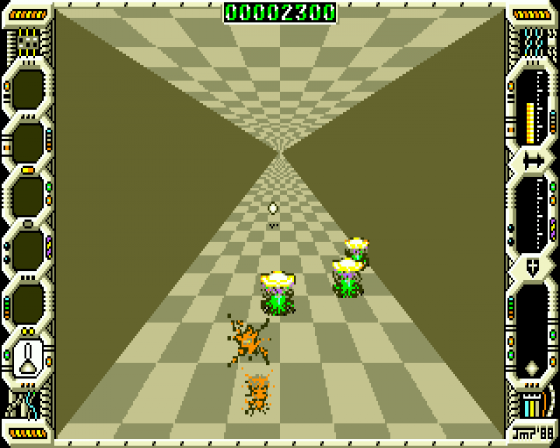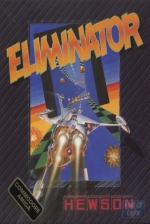
The One
 1st October 1988
1st October 1988
Categories: Review: Software
Publisher: Hewson Consultants
Machine: Amiga 500
Published in The One #1
Hewson's first original 16-bit product was initially designed as a motorbike racing game featuring tunnels which the bike would be able to ride up, in true 'Wall Of Death' style. However, technical problems meant that this idea was dropped in favour of a different approach. Steve Jarratt takes a closer look...
Eliminator (Hewson Consultants)
Eliminator takes the player on a high speed race through a tortuous alien roadway set over fourteen levels. Each section features tunnels, hills and curves which are effectively portrayed by an extremely smooth 3D update. Similarly, alien formations approach out of the distance shooting missiles, and a variety of static objects appear to be shot, dodged or leaped over using ramps.
The aim is simply to progress as far as possible, and the player is provided with four craft for this purpose. The ship travels at a constant speed and is simply directed to left and right and the blasters operated by the fire button. The course layout always remains constant, allowing a mental map of the route to be built up.
The player's craft is vulnerable to alien firepower and therefore carries armour which is replenished by collecting icons along the route. Further icons allow the ship's weaponry to be improved sequentially, from the standard single shot blaster, to one of five powerful and directional variations.

The end of each level is signified by entering a large portal, at which point the current score is calculated and the ship's armour topped up. Also, every other level releases a secret code which allows the player to re-enter the game without having to play through the earlier sections. However, the ship always starts with the minimum firepower, so starting from scratch is usually the preferred option.
The number of 3D racing games has vastly increased over the last few months, many of which - particularly the coin-op conversions - have been disappointing. Although not as complex as many of its predecessors, Eliminator does, however, succeed in creating a believable and exhilarating sensation of movement, and provides a challenging and enjoyable dodge shoot-'em-up which should keep most players happy for several months.
John Phillips
Although previously an unknown quantity to 16-bit owners, John Phillips has been programming games for the last couple of years on the popular 8-bit machines. (Just for the record, his earlier successes include Impossaball, Sunburst and Nebulus - now on the ST, and our cover disk for that matter!). It was with the latter product that he had his first major hit: it was received to critical acclaim and reasonable sales in the high street.

After completing Nebulus, John moved onto the ST and his first 16-bit project, Eliminator. The transition from 8- to 16-bit was made less problematic due to the fact that John had been using the larger machines during his University days when he studied cybernetics. He also feels that the ST is easier to program than the 8-bit machines. "I started Eliminator last November. However I wasn't pleased with my efforts, so I scrapped it in February and started again from scratch. It then took me another three or four months to complete it. I learned a lot during the previous four months but I suppose I do work quickly."
The speed at which John can finish projects is emphasised by the ST conversion of Nebulus: Andrew Hewson farmed the project out to another software house who struggled for three months without any real progress. John then decided to do it himself and completed it in a month!
John's games are all recognisable as being innovative and unusually presented. And, although proud of the idea for Nebulus, John admits that it was more a product of luck than a fertile imagination: "I was working on a Uridium-style shoot-'em-up for the Spectrum, where the player had to negotiate the surface of a constantly rotating horizontal tube littered with raised constructions. Technical problems forced me to move the project elsewhere, and during its implementation on the C64, I turned the tube on end. It was then just a simple matter of converting it into a platform game.

"I always try to incorporate simple or easy to learn gameplay into a totally different environment. I prefer games which work on a 'levels' principle, rather than with a large, sprawling gameplay. I also like to create a sense of atmosphere. In Nebulus I wanted the player to feel as if he could reach out and grab the towers; or reach into the screen in the case of Eliminator."
John sees his latest project as a follow-up to Nebulus, in that it uses the rotating routines as its inspiration. He plans to have the player's craft on the surface of a rotating sphere with aliens moving around its surface in true 3D. It's definitely a 16-bit only game - and he's still not sure whether the ST can cope with the maths or not.
John likes playing as well as programming, although he rarely has the time to do so. His favourite at the moment is Virus, and he's looking forward to seeing Whirligig and Damocles.
ST

Eliminator is a very smooth and polished game, being well presented and beautifully designed. Progress is a challenging and continuous process, by dint of the nicely graded levels, and the code entry system is also a particularly welcome inclusion. The graphics are of a very high standard, with some very smart sprites and possibly the smoothest 3D update so far. The ST's sound chip is used to the best of its ability, and features some decent effects and a droning, but strangely pleasant, soundtrack throughout play.
Eliminator will be widely available in October and comes highly recommended for some addictive, high speed action.
Amiga
The Amiga version of Eliminator should be available at the same time as the ST version, but it's currently being written by Marcus Grimmer in Switzerland and was unavailable for review at the time of going to press. Rather than being ported straight over, Hewson are currently improving the music and sound effects, and refining the graphics. The ability to use the blitter also frees a large amount of memory, so there should be even more levels to play through.
Other Reviews Of Eliminator For The Amiga 500
Eliminator (Hewson)
A review
Eliminator (Hewson Consultants)
A review by Steve Jarratt (Commodore User)
Scores
Atari ST Version| Graphics | 87% |
| Sound | 74% |
| Playability | 90% |
| Value For Money | 78% |
| Overall | 85% |
Scores
Amiga 500 Version| Graphics | 87% |
| Sound | 74% |
| Playability | 90% |
| Value For Money | 78% |
| Overall | 85% |











